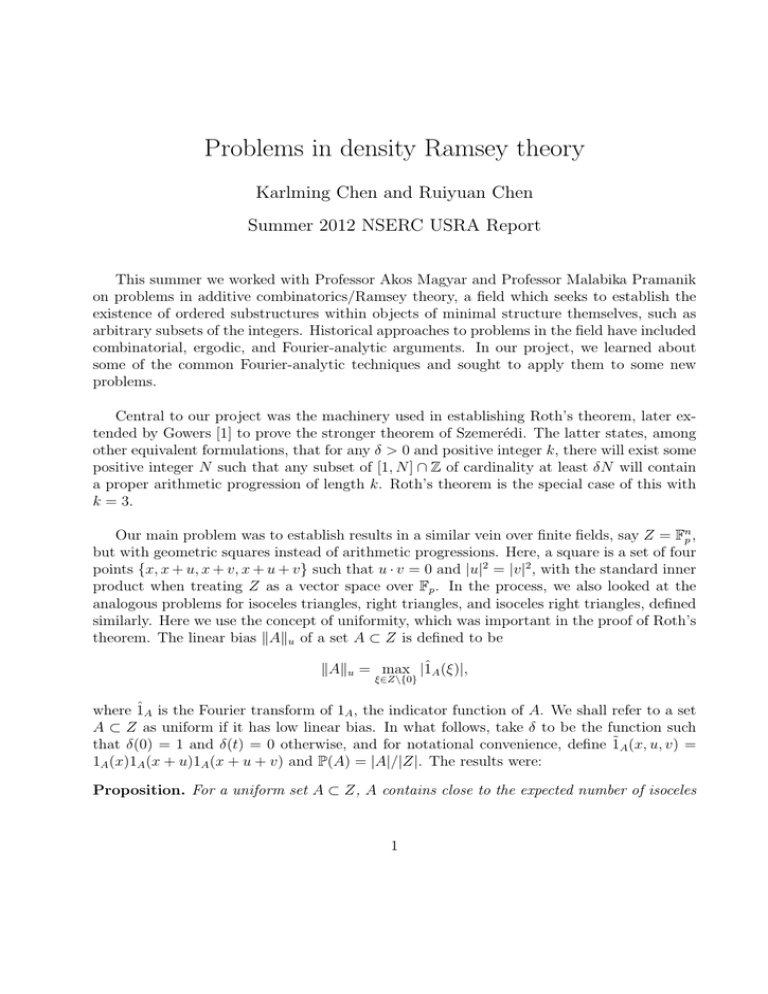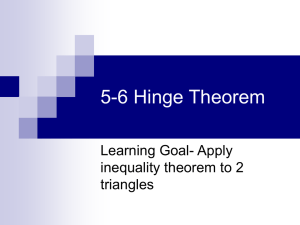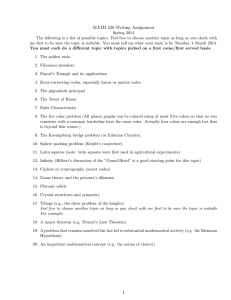Problems in density Ramsey theory Karlming Chen and Ruiyuan Chen
advertisement

Problems in density Ramsey theory
Karlming Chen and Ruiyuan Chen
Summer 2012 NSERC USRA Report
This summer we worked with Professor Akos Magyar and Professor Malabika Pramanik
on problems in additive combinatorics/Ramsey theory, a field which seeks to establish the
existence of ordered substructures within objects of minimal structure themselves, such as
arbitrary subsets of the integers. Historical approaches to problems in the field have included
combinatorial, ergodic, and Fourier-analytic arguments. In our project, we learned about
some of the common Fourier-analytic techniques and sought to apply them to some new
problems.
Central to our project was the machinery used in establishing Roth’s theorem, later extended by Gowers [1] to prove the stronger theorem of Szemerédi. The latter states, among
other equivalent formulations, that for any δ > 0 and positive integer k, there will exist some
positive integer N such that any subset of [1, N ] ∩ Z of cardinality at least δN will contain
a proper arithmetic progression of length k. Roth’s theorem is the special case of this with
k = 3.
Our main problem was to establish results in a similar vein over finite fields, say Z = Fnp ,
but with geometric squares instead of arithmetic progressions. Here, a square is a set of four
points {x, x + u, x + v, x + u + v} such that u · v = 0 and |u|2 = |v|2 , with the standard inner
product when treating Z as a vector space over Fp . In the process, we also looked at the
analogous problems for isoceles triangles, right triangles, and isoceles right triangles, defined
similarly. Here we use the concept of uniformity, which was important in the proof of Roth’s
theorem. The linear bias kAku of a set A ⊂ Z is defined to be
kAku = max |1̂A (ξ)|,
ξ∈Z\{0}
where 1̂A is the Fourier transform of 1A , the indicator function of A. We shall refer to a set
A ⊂ Z as uniform if it has low linear bias. In what follows, take δ to be the function such
that δ(0) = 1 and δ(t) = 0 otherwise, and for notational convenience, define 1̃A (x, u, v) =
1A (x)1A (x + u)1A (x + u + v) and P(A) = |A|/|Z|. The results were:
Proposition. For a uniform set A ⊂ Z, A contains close to the expected number of isoceles
1
triangles, right triangles, and isoceles right triangles. Quantitatively, for right triangles:
3
1
P(A)
2
Ex,u,v∈Z 1̃A (x, u, v)δ(u · v) −
≤ P(A)
+ kAku .
p pn
For isoceles triangles:
2
3
Ex,u,v∈Z 1̃A (x, u, v)δ(|u|2 − |v|2 ) − P(A) ≤ P(A) + P(A)kAku .
p pn
For isoceles right triangles:
3
2
3
Ex,u,v∈Z 1̃A (x, u, v)δ(u · v)δ(|u|2 − |v|2 ) − P(A) ≤ P(A) + P(A) + 1 + p−n/2 P(A)kAku .
n/2
n
p
p
p
Here, we say “expected” as based on naively treating the events of x, x + u, and x + u + v
falling in A as probabilistically independent. Each constraint further introduces a factor of
1/p, if we assume that the expressions u · v and |u|2 − |v|2 are uniformly distributed among
the p possible values. With regards to squares, we have the following result for rectangles:
Proposition. A set A ⊂ Z will contain many rectangles:
4
Ex,u,v∈Z 1̃A (x, u, v)1A (x + u + v)δ(u · v) ≥ P(A)
p
To arrive at an estimate for squares, we treated the rectangle estimate as the main contributing term, and bounded the error term (counting rectangles that are not squares) from
above. This was done in two separate ways, one of which did not require the assumption
of uniformity. In any case, via a intermediate result from the proof of Roth’s theorem, the
assumption of uniformity can be dropped.
The specific case of squares on the two-dimensional space F2p was also examined. It
was established that the previous criterion of uniformity was insufficient via an explicit
probabilistic construction of uniform sets in F2p that have fewer than the expected number
of squares, adapted from a construction of Gowers. However, we found that the number of
squares can be controlled by the U 3 Gowers norm, and this was established in a proof closely
emulating that of Gowers [1][2] for the k = 4 case in Szemerédi’s theorem, which also utilized
the U 3 norm.
References
[1] W. T. Gowers. A new proof of Szemerédi’s theorem. Geometric and Functional Analysis.
[2] T. Tao and V. Vu. Additive combinatorics.
2


